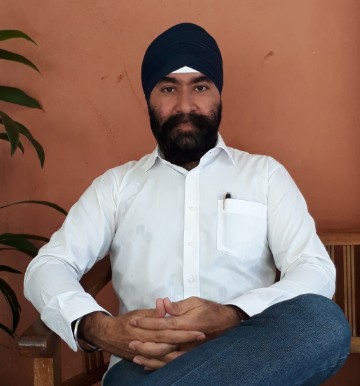
In the last couple of years, you may have come across various articles, books and even YouTube videos of people proclaiming the DG is or is not the composition of Guru Gobind Singh. My sole purpose of preparing this article is to provide sufficient pointers and evidence that will hopefully help you take a stand and make a decision whether to accept the DG wholly as the works of Guru Gobind Singh or not.
FACT: There are many Sikhs out there who have not heard or read the DG for themselves. For the ones who have read, some may NOT have understood the content.
Why has this happened? Probably due to these reasons:
- The Sikh clergy and a few staunch groups have put fear amongst practicing Sikhs saying they know Sikhi better and do not appreciate anyone questioning them. If you do, they say you have lack of ‘sharda’ (reverence).
- The DG is composed in several older languages mainly Brij Pasha, Persian etc. which the modern day Sikh cannot understand.
- Most of the English translations of the DG is misleading and inaccurate.
Why I Decided To Write About The DG?
In April of 2016, the Malaysian Gurdwara Council (MGC) wrote an official letter to the committee of Titiwangsa Gurdwara to stop SGGS Academy from proceeding with a 3-day program named “Akaal Ustat Semagam”.
The academy ignored the MGC letter and boldly went ahead with the 3-day program. They even ignored to abide the Sikh Rehat Maryada (SRM) and Akaal Takhat’s directive to only sing, recite and do viaakhia of Gurbani from Guru Granth Sahib or Bhai Gurdaas Vaaran and nothing more.
SGGS Academy (in my personal opinion), was a fine academy. They were well received when they were focused on Gurbani from Guru Granth Sahib. But soon as they entered the domain of the DG, it was a downward spiral.
Let’s take a look at how the DG debacle actually started.
The DG Beginnings (Historical Evidence)
Ever since the demise of Guru Gobind Singh in 1708, many anti-Sikh groups sprung up to create chaos and put a blemish on Sikhs and the Guru’s name.
Let it be known that a Giani Gian Singh has recorded that Guru Gobind Singh did indeed compose a few compositions but they were NEVER compiled in a book form.
All the 10th Guru’s compositions were found in separate sheets and some may have been transferred into texts called Rehatnamas (eg. Bhai Nand Lal, Bhai Dessa Singh, Bhai Chaupa Singh, Bhai Daya Singh and Bhai Prahlad Singh.)
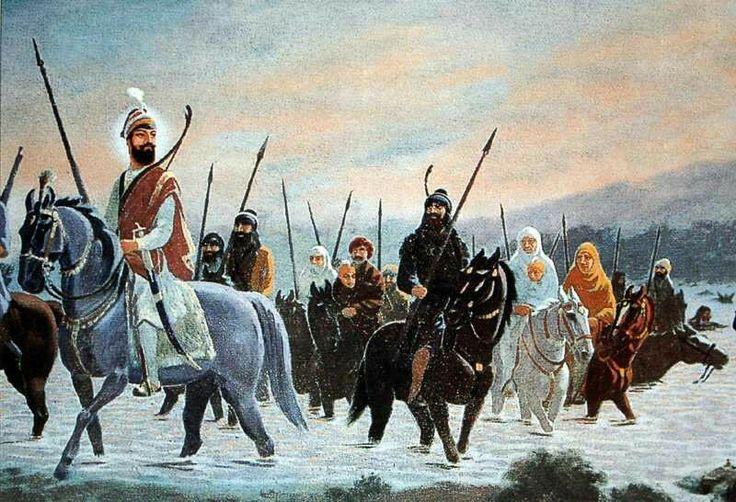
It is said that in 1721, Bhai Mani Singh was collecting the writings of the 10th master but it is also known that most of the compilations were lost in 1704, during the evacuation of the Guru and His family members together with a handful of his soldiers from Anandpur Fort.
During this time, some of the writings of the 10th Guru also got lost when Guru Sahib and others were crossing the Sirsa river. In 1738, Bhai Mani Singh was martyred.
So, basically, NO one really knows where or what are the exact authentic writings of the 10th Guru.
In 1785, (77-years after Guru Gobind Singh left this world), a granthi by the name of Sukha Singh together with two of his companions began compiling and writing a book called Bachitar Natak. A few copies of this Bachitar Natak were made available back then.
In 1897, a group of Sikhs from Gurmat Granth Parchaar Sabha, Amritsar, under the leadership of one Bhai Gurmukh Singh went about collecting copies of Bachitar Natak and other supposedly Guru Gobind Singh’s writings from gurdwaras, homes and libraries from all over Punjab.
They gathered 32 different versions of Bachitar Natak (now allegedly called Dasam Granth). Their justification of taking up such an arduous task was to come up with a final “true copy” of the writings of the 10th Guru and to compile everything in one volume or book.
NOTE: From these 32 different versions collected, eight (8) compositions of Guru Gobind Singh were NOT included in the final copy of the man-made DG.
List of eight (8) compositions not included:
- Sri Sahib Ji Ki Ustat Patshahi 10
- Shand Chakka Sri Bhagauti Ju Ka
- Sri Bhagwat Gita Sri Gobind Singh Kirt
- Sansahar Sukhmana Sri Mukhwak Patshahi 10 Raag Gauri
- Shabd Asa Tatha Sorathi Patshahi 10
- Vaar Malkauns Ki Patshahi 10
- Vaar Bhagauti Ji Ki Sri Mukhwak Patshahi 10
- Asfotak And Kabit Swaiyye
Three (3) baanis, namely Jaap Sahib, Tev Parsaad Sawaiyye, Benti Chaoupai were ADDED in the later versions of the DG. These baanis were NOT part of the Bachitar Natak initially.
The writer(s) of DG must have decided to affix Guru Gobind Singh Ji’s name and include some of the Guru’s baanis in the DG in order to create more credibility to their claims that the DG was written by the Guru himself.
A Bhai Manna Singh, who was put in charge of this task, writes in his Sodhak Report.
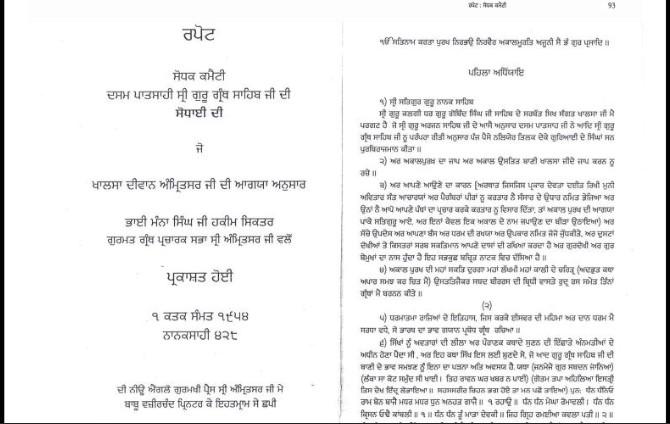
According to this report, 32-collected manuscripts were taken to Manna Singh’s house and upon completing the intended task, all 32 were returned to the original owners.
This is however untrue! Not even a single manuscript is to been found today.
What may have happened, according to some resources:-
Upon deciding which writings or compositions they were going to include and exclude, they burnt ALL 32 copies and since they promised to return the original 32 versions to the families, they must have prepared the new DG volume and sent these instead. Unfortunately, not even a single copy has surfaced to date.
Questions to ponder upon:
- Why isn’t even one copy of the original 32-manuscripts of Bachitar Natak anywhere to be found?
- What was Akaal Takhat and SGPC doing at that time when Khalsa Diwan’s and Gurmat Granth Parchaar Sabha’s started the compositions hunting and re-compiling, making corrections, etc? Which authority sanctioned and surpervised this work?
- Who has verified Sodhak Committee’s report of the new DG?
- Are we 100% sure all of the DG consists of authentic writings of Guru Gobind Singh?
- If Guru Gobind Singh or the poets in His courts (like some claim) wrote the DG, then why aren’t they allowing ‘carbon dating’ on the “original DG”? What are they afraid of?
These are some very important questions which have gone unanswered.
For those who are not familiar with ‘carbon dating’, it’s a scientific process of determining how old is an item. You can read all about this process here. https://en.wikipedia.org/wiki/Radiocarbon_dating
FACT: From 1721 to 1897 (for 176 years), there was NO such book called Dasam Granth.
If the DG did exist, I believe Guru Ji would have either inserted the compositions within Guru Granth Sahib or he would have informed His Sikhs and made copies of it for distribution. Since the Guru was already inserting compositions of his father – Guru Tegh Bahadhur Ji’s Baanis in Adi Grath.
In fact, Guru Ji could have easily included His own Baanis too but He didn’t, reasons best known to the Guru. We are not to assume or judge.
So what’s inside the DG?
Content Structure of The Dasam Granth
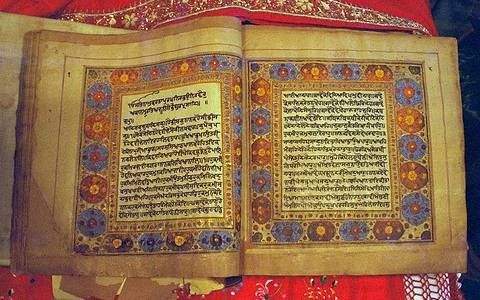
The standard edition of the text contains 1,428 pages with 17,293 verses in 18 sections.
The poems are mostly in Brij language (old western Hindi), with some parts in Avadhi, Punjabi, Hindi and Persian. The script is written almost entirely in Gurmukhi, except for Guru Gobind Singh’s letters to Aurangzeb—Zafarnama and the Hikaaitaan—written in the Persian alphabet.
Contents are categorized and structured as such:
- Jaap Sahib
- Akaal Ustat
- Bachitar Natak – Depicting Guru Gobind Singh’s previous birth and Hemkunt mythology. (36 pages)
- Chandi Charitras 1 & 2 – the character of Goddess Chandi
- Chandi Di Vaar – Prayers to Goddess Durga
- Gian Parbodh – The awakening of knowledge
- Chaubis Avtaar – Stories of God in human and animal form. 24 incarnations of Vishnu (674 pages)
- Brahma Avtaar – Incarnation of Brahma
- Rudar Avtaar – Incarnation of Shiva
- Shabad Hazare
- 33 Swaiyye
- Swaiyye Khalsa Mehma – Praises of the Khalsa
- Sri Shastra Naam Mala Puran Likhyate – A list of weapons.
- Charitropakhyan – Sexual, erotica, degradative stories (615 pages)
- Kabeo Bach Benti Chaupai
- Zafarnamah
- Hikayats
Jaap Sahib, Tev Parsaad Svaiyye, Benti Chaupai
But these 3 compositions bear Guru Gobind Singh’s name as the author? Well, to be honest, there is no 100% surety of this either. Let me explain.
Some parts in all of these 3 baanis bear some resemblance to Guru Gobind Singh’s poetry writing style and is inline with Gurmat too. But there are many sections within the same compositions, which are inconsistent and deviates from Guru Granth Sahib’s philosophy. So, its really hard to say.
Akaal Takhat and Shiromani Gurdwara Parbandhak Committee (SGPC) have confidently inserted these 3-baanis in the SRM (Sikh Rehat Maryada), in the Nitnem Gutkas (daily prayer booklets). These compositions are also recited during the ‘Amrit Sanchaar’ (baptizing) ceremony.
Why did Akaal Takhat and SGPC include these compositions when parts of the compositions were doubtful and not in-line with Gurmat?
Here is perhaps one of the reasons:
In 1931, SGPC was being pressured by the Sikh community to come up with a final draft of the Sikh Code of Conduct (Sikh Rehat Maryada). Several Sikhi groups, historians, authors and Sant-Baba deras were invited to prepare it. The Sant-Babas and Nihang Singhs insisted to include the 3-preseumed Baanis of the 10th Guru as part of the the daily Nitnem in the SRM but I believe some members disagreed. After much deliberation and argument, SGPC decided to go ahead and include only 3-compositions (Jaap Sahib, Tev Parsaad Sawaiyye and Benti Chaoupai). The first SRM was hence, published.
What if I told you, there is evidence pointing to Jaap Sahib is NOT entirely Guru Gobind Singh’s composition. (Read on…)
Where Did The Contents of The DG Actually Come From?
The DG is a compilation of several texts and manuscripts of different times and various authors. The compositions were collected over time, and then compiled into the large voluminous book – the DG as we see it today (1428 pages).
-
Markandey Puraan
Parts of the DG content derives from this ancient text called Markandey Puraan. It’s a huge voluminous book. The book carries some 6,900 verses in Sanskrit and it is believed to have been written by a sage called Markandey. The content itself is said to have originally been written on palm-leaves dating back as far Circa 250CE. It is probably one of the oldest among the eighteen major Puranas in Hinduism centering around the Hindu Goddess Dewi Mahatmya. Most of the stories are linked to Lord Shiva and Lord Vishnu as well.
> https://en.wikipedia.org/wiki/Markandeya_Purana
. -
Shiv Puraan
This particular Hindu text is an interesting one. Why? Because one of the Nitnem baanis – Jaap Sahib, which is said to have been composed by Guru Gobind Singh is actually found in this Hindu scripture. Are you surprised? I was.
> https://en.wikipedia.org/wiki/Shiva_Purana
. -
Bhagwat Puraan
A huge section within the DG’s content also derives from an ancient text called Bhagwat Puraan. In the DG you see the section which talks about “Dasam Sikandh” actually comes from this Puran (word for word). Basically, it’s all about the life stories of Lord Vishnu or Lord Krishna, from birth, his experiences, his growing up years, his wars and his greatness, etc. Sadly, the authors of DG had the cheek to label it as “Patshahi 10”, putting Guru Gobind Singh’s name as the composer.
> https://bhagavata.org/
. -
Rest of The Contents
The rest of the DG’s tales and stories derive from several ancient Hindu texts namely:
– Betaal Batisi
– Singhasan Batisi
– Panch Tantar
– Katha Sehet Sagar,
– Alif Leila,
– Ayar Danas
Some of the stories were also narrated by ordinary people who memorized the stories by heart which were passed down to them ORALLY from one generation to another.
We know all too well of how a simple sentence, when orally transmitted or whispered from person No. 1 up to person No.20, usually ends up distorted and different from the original sentence.
What About Rehatnamas?
There are mentions of the 3 Baanis in it too but Rehatnamas were written by third parties and NOT Guru Gobind Singh himself. There is no ONE identical copy of the Rehatnama. All carry some similarities and some differences too.
With several different versions of the Rehatnamas around, which ones do we seek to get further validation from? It is also likely, over the years, several additions and subtractions of the Rehatnamas were made, which makes validation even more difficult.
Who Is The Real Author of Dasam Granth (Bachitar Natak)?
When I mention Dasam Granth (DG) it means Bachitar Natak as these are the same one book but deliberately given different names.
The current version of the DG was compiled by 3 poets – Kavi Raam, Kavi Sham and Kavi Kaal. No one knows who they are or if they even actually existed.
The writers of the DG might have used these names to shield their own identities.
Whom Did The Poets Worship?
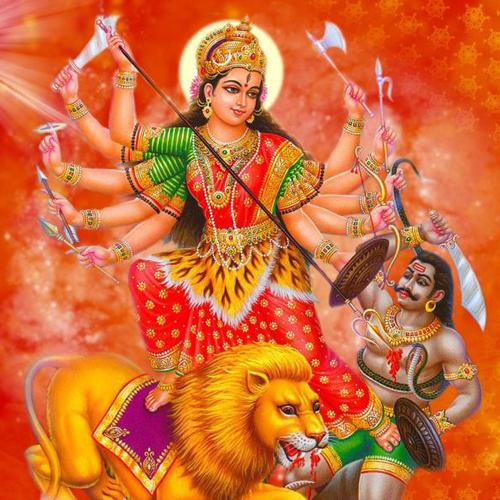
The DG writers were without an iota of doubt, worshippers of Mahakaal or Kalka (pic above). Mahakaal is a fierce manifestation of the Hindu God Shiva and the consort of the Goddess, Mahakali.
In fact, they admitted to this in the DG.
![]()
Sarabkaal Hai Pitaa Apaara, Deb Kalka Maat Hamara|| (DG, page 73)
Deb Kalka is being referred to as Dewi Kaalka. Mahakaal is the male name for their God. All other names eg. Dewi Bhagauti, Bhagwati, Bhweshan, Bhawani, Chandi, Kaalka, Durga etc are referring to the same female Goddess Kaalka but in various names.
Thier claims were basically outright lies trying to make it appear as if Guru Gobind Singh was a follower of Dewi Kaalka. That the Gurus were worshippers of the Hindu Gods and Goddess. They wanted to make it look as if the Sikh faith was an off-shoot of Hinduism and Sufism. In fact, they wanted to make SGGS their 5th Veda.
They even stated that when Guru Gobind Singh uttered the supplication “Prithm Bhagauti Simar Ke, Guru Nanak Layiee Dhiaye”, it means Guru Gobind Singh himself first meditated on Dewi Kaalka and derived His powers to eliminate His enemies with the Goddess ‘shakti’ (powers) and then only Guru Gobind Singh meditated upon Guru Nanak.
Do you think Guru Gobind Singh, who sat on the throne of Guru Nanak, would have meditated upon Dewi Kaalka first and then remembered Guru Nanak?
The intentions of the writers of the DG is obvious. They want to split the Sikh sanggat and break the Sikh spirit, creating much confusion. (To an extent, I think they may have achieved this goal.)
The writers of the DG had another intention too.
They planned to create a dichotomy – splitting Guru Gobind Singh from Guru Nanak’s philosophy and Gurmat, hence their game-plan of weakening the Sikh spirit and casting Guru Nanak’s ideology aside and placing their ‘Bhramanwaad’ ideology into the limelight.
DG Writing Style is NOT in Tandem with SGGS
Our Guru’s have composed every line of shabad within Sri Guru Granth Sahib. When we see the word Mehalla it identifies which Guru is the author of the said shabad.
So, Mehalla 1 denotes Gur Nanak as the author, Mehalla 2 denotes Guru Angad, Mehalla 5 denotes Guru Arjan and so on. You will never find a Mehalla anywhere within the pages of the DG.
As we all know, Guru Gobind Singh did prepare the final Adi Granth when he wanted to include His father’s (Guru Tegh Bahadhur Ji’s – Saloks) in it. Why would He not use the same technique of writing Mehalla 10 in the DG? Instead you will find the words, “Sri Mukhvaak Paatshahi Das” (From the mouth of the 10th Guru)
NO Sikh Guru has written His own name before or after a Gurbani shabad within SGGS but in the DG, you will find ample places where Guru Gobind Singh is referring to himself as the author. Why would the Guru break the tradition and instead write His own name openly everywhere?
Secondly, every time a section or group of shabads begins in SGGS, it begins with a ‘mool’. Eg. Ik Onkaar Satgur Parsaad ; Ik Ongkaar Satnam Karta Purakh Nirbhau Nirvair Akaal Moorat Ajooni Saibhang Gurparsaad.
This too cannot be found anywhere in the older versions of the DG. Someone within the group must have realized this and so they began adding in the ‘mools’ and other ‘Gurbani-like’ wordings in the recent publications but none of these were found in the earlier versions. Peculiar, don’t you think?!
The Name of the DG Has Been Changed Several Times
The original name of the Dasam Granth (DG) is actually Bachitar Natak.
This is evident from 3 old manuscripts that have been found from 3 different villages in India; namely, Sarharanpur, Patna and Patiala which clearly states the name ‘Bachitar Natak’ on the cover.
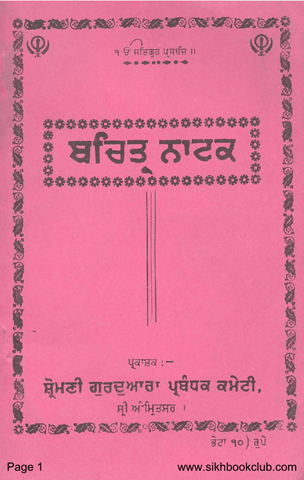
What are the previous known names of the DG?
- Bachitar Natak (original name of the 1st compilation)
- Samundar Sagar
- Vidya Sagar
- Dasam Granth
- Dasam Padshah Ka Granth
- Sri Dasam Granth Sahib
- Dasam Sri Guru Granth Sahib
Question: Why change the name of the DG several times?
A few probable answers are:
- Throughout the years, the writers and publishers of Bachitar Natak made countless edits, additions, subtractions etc from the original manuscript. To reflect the changes, new copies were printed out.
. - The writers of DG wanted to make the DG more acceptable amongst Sikhs. The earlier versions must have had a hard time being accepted by the masses. Simply by changing the title of the book, adding similar writing style of the Guru, trying to matching the structure to SGGS with a new cover and title would do the trick.
. - The other reason they changed the name of the DG is because they wanted to place DG on par with SGGS. To rename the DG from Bachitar Natak to Dasam Sri Guru Granth Sahib will certainly get the attention of Sikhs worldwide.
In my opinion, there is no need to change the name of a book IF such a book has massive appeal and acceptance. By changing the name, not once but 7 times, it raises even more questions. People start to get suspicious. Why the need to change the name of a religious book so many times?
FACT: The author(s) of the current man-made DG are anti-Sikhs, anti-Gurmat mischiefs.
They deliberately planned to change the name, copying some of Guru Gobind Singh’s original compositions and adding them into the DG. In fact, in some places they even edited the compositions, inserting their own lines and paras. A third of the DG (615-pages out of 1428 pages) are dedicated to sexually explicit, totally obscene, degrading erotica stories (hikayats).
Contents of Woman Degradation, Humiliation and Extreme Obscenity.
I don’t intend to offend anyone but I think it’s important for us to know exactly what kind of deragatory content is within the DG.
The entire section called Charitropakhyan, contains 404 stories of extreme profanity, sexuality, homo-sexuality, extreme erotica which is deragatory towards man, woman, mothers, wifes and even children.
Let’s see some sample writings within the DG.
WARNING! DO NOT RECITE OR NARRATE THE FOLLOWING STORIES LOUDLY IN FRONT OF YOUR KIDS, MOTHER OR SISTER.
(Readers discretion is highly advised)
Sample Story 1: Charitar No. 10
This excerpt is from page 1521 of the DG (Charitar No.10)
…ਬਨਿਯਾ ਏਕ ਪਿਸੌਰ ਮੈ ਤਾਹਿ ਕੁਕ੍ਰਿਆ ਨਾਰਿ ॥
ਤਾਹਿ ਮਾਰਿ ਤਾ ਸੌ ਜਰੀ ਸੋ ਮੈ ਕਹੋ ਸੁਧਾਰਿ ॥੨॥
ਬਨਿਕ ਬਨਿਜ ਕੇ ਹਿਤ ਗਯੋ ਤਾ ਤੇ ਰਹਿਯੋ ਨ ਜਾਇ ॥
ਏਕ ਪੁਰਖ ਰਾਖਤ ਭਈ ਅਪੁਨੇ ਧਾਮ ਬੁਲਾਇ ॥੩॥
ਰੈਨਿ ਦਿਵਸ ਤਾ ਸੌ ਰਮੈ ਜਬ ਸੁਤ ਭੂਖੋ ਹੋਇ ॥
ਪ੍ਰੀਤ ਮਾਤ ਲਖਿ ਦੁਗਧ ਹਿਤ ਦੇਤ ਉਚ ਸੁਰ ਰੋਇ ॥੪॥
ਚੌਪਈ ॥
ਜਬ ਸੁਤ ਭੂਖੋ ਹੋਇ ਪੁਕਾਰੈ ॥ ਤਬ ਮੁਖ ਸੌ ਯੌ ਜਾਰ ਉਚਾਰੈ ॥
ਤ੍ਰਿਯ ਯਾ ਕੋ ਤੁਮ ਚੁਪਨ ਕਰਾਵੋ ॥ ਹਮਰੇ ਚਿਤ ਕੋ ਸੋਕ ਮਿਟਾਵੋ ॥੫॥
ਉਠਿ ਅਸਥਨ ਤਾ ਕੋ ਤਿਨ ਦਯੋ ॥ ਲੈ ਅਸਥਨ ਚੁਪ ਬਾਲ ਨ ਭਯੋ ॥
ਨਿਜ ਸੁਤ ਕੋ ਨਿਜੁ ਕਰਨ ਸੰਘਾਰਿਯੋ ॥ ਆਨਿ ਮਿਤ੍ਰ ਕੋ ਸੋਕ ਨਿਵਾਰਿਯੋ ॥੬॥
ਬਾਲ ਰਹਤ ਚੁਪ ਜਾਰ ਉਚਾਰੋ ॥ ਅਬ ਕ੍ਯੋ ਨ ਰੋਵਤ ਬਾਲ ਤਿਹਾਰੋ ॥
ਤਬ ਤਿਨ ਬਚਨ ਤਰੁਨਿ ਯੌ ਭਾਖਿਯੋ ॥ ਤਵ ਹਿਤ ਮਾਰਿ ਪੂਤ ਮੈ ਰਾਖਿਯੋ ॥੭॥…
Taahe Maar Taa Sou Jaree So Mai Kaho Sudhaar ॥2॥ Banik Banaj Ke Hith Gayo Taa Te Raheyo Na Jaey ॥ Eek Purakh Raakht Bhaee Apne Dhaam Bulaae ॥3॥ Raein Divas Taa Sou Remaei Jab Sut Bhookho Hoey ॥ Preet Maat Lakh Dugadh Hith Det Ouch Sur Roey ॥4॥ Choupaee ॥ Jab Sut Bhookho Hoei Pukaarey ॥ Tab Mukh Sou Yo Jaar Ouchaarey॥ Trey Yaa Ko Tum Chuppan Keraavo ॥ Humrey Chit Ko Sok Mittaavo ॥5॥ Outh Asthn Taa Ko Tin Deyo ॥ Lai Asthn Chup Baal Na Bheyo ॥ Nij Sut Ko Nij Karn Saanghaareyo ॥ Aan Miter Ko Sok Nevaareyo ॥6॥Baal Rehet Chup Jaar Ouchaaro ॥ Ab Kyo Na Rovat Baal Tehaaro ॥ Tab Tin Bachan Turen Yo Phaakheyo ॥ Tv Hith Maar Poot Mai Raakheyo ॥7॥
Meaning,
…A shopkeeper used to live in the city of Peshawar, whose wife was overcome by lust and evil misdeeds. The shopkeeper went away on a business trip. In his absence she invited a person to live with her in her house.(3)
She had a child and whenever the child was hungry, it cried for milk, but, day in or day out, she kept herself busy in fulfilling hers and her lovers sexual desires; love-making.(4) Chaupaee. Once when the baby was really hungry, and cried loudly seeking to be fed, her lover instructed her, “Go, silence the child and then comeback.”(5)
The lady went and tried to breast feed her baby but the child still carried on crying and wouldn’t keep quiet. So, to quieten her baby, she strangled and suffocated the baby with her bare hands. Killing the child, she went back to her lover and continued to make-love to him.(6)
Her lover, noticed the baby has suddenly stopped crying, asks her, “Why has the baby stopped crying?”. She then tells him, “For the sake of your pleasure, I have killed my baby.”(7)…
- Do you find this story spiritually uplifting?
- Is it related to Gurmat of Sri Guru Granth Sahib Ji in any way?
- Is there any good moral value to this story for mankind’s benefit?
- What kind of message does it give to the reader?
Let’s see – Being an irresponsible mother is ok. Committing adultery is ok. Ignoring your baby’s need is ok. Killing your child is OK. Satisfying your lovers needs and sexual desires is more important than life itself.
Do you think Guru Gobind Singh would have written or compiled such derogatory story for us Sikhs to read and recite? I mean can you even imagine this story being narrated, sung and the meanings explained by a Granthi in a Gurdwara program?
Sample Story 2: Charitar No. 134
Here is another one. This is Charitr No.134 (Page 1011) from the DG.
ਸਬਕ ਸਿੰਘ ਰਾਜਾ ਇਕ ਭਾਰੀ ॥ ਬਾਜ ਮਤੀ ਤਾ ਕੀ ਬਰ ਨਾਰੀ ॥ ਕਾਹੂ ਸੋ ਨਹਿ ਰਾਵ ਲਜਾਵੈ ॥ ਸਭ ਇਸਤ੍ਰਿਨ ਸੋ ਕੇਲ ਕਮਾਵੈ ॥੧॥
ਜੋ ਇਸਤ੍ਰੀ ਤਿਹ ਕਹੇ ਨ ਆਵੈ ॥ ਤਾ ਕੀ ਖਾਟ ਉਠਾਇ ਮੰਗਾਵੈ ॥ ਅਧਿਕ ਭੋਗ ਤਾ ਸੋ ਨ੍ਰਿਪ ਕਰਈ ॥ ਰਾਨੀ ਤੇ ਜਿਯ ਨੈਕ ਨ ਡਰਈ ॥੨॥
ਬਾਜ ਮਤੀ ਜਿਯ ਅਧਿਕ ਰਿਸਾਵੈ ॥ ਸਬਕ ਸਿੰਘ ਪਰ ਕਛੁ ਨ ਬਸਾਵੈ ॥ ਤਬ ਤ੍ਰਿਯ ਏਕ ਚਰਿਤ੍ਰ ਬਿਚਾਰਿਯੋ ॥ ਰਾਜਾ ਕੋ ਦੁਰਮਤਿ ਤੇ ਟਾਰਿਯੋ ॥੩॥
ਰੂਪਵਤੀ ਜੋ ਤ੍ਰਿਯ ਲਖਿ ਪਾਵੈ ॥ ਸਬਕ ਸਿੰਘ ਸੋ ਜਾਇ ਸੁਨਾਵੈ ॥ ਤੁਮ ਰਾਜਾ ਤਿਹ ਤ੍ਰਿਯਾ ਬੁਲਾਵੋ ॥ ਕਾਮ ਕੇਲ ਤਿਹ ਸਾਥ ਕਮਾਵੋ ॥੪॥
ਜਬ ਯੌ ਬਚਨ ਰਾਵ ਸੁਨਿ ਪਾਵੈ ॥ ਤੌਨ ਤ੍ਰਿਯਾ ਕੋ ਬੋਲਿ ਪਠਾਵੈ ॥ ਜਾ ਕੀ ਰਾਨੀ ਪ੍ਰਭਾ ਉਚਾਰੈ ॥ ਤਾ ਕੇ ਰਾਜਾ ਸੰਗ ਬਿਹਾਰੈ ॥੫॥
ਯਾ ਮੈ ਕਹੋ ਕਹਾ ਘਟ ਗਈ ॥ ਜਾਨੁਕ ਹੋਹੂੰ ਭਿਟੋਅਨਿ ਭਈ ॥ ਜਾ ਤੇ ਮੋਰ ਰਾਵ ਸੁਖ ਪਾਵੈ ॥ ਵਹੈ ਬਾਤ ਹਮਰੇ ਜਿਯ ਭਾਵੈ ॥੬॥
ਬਲੀ ਏਕ ਸੁੰਦਰ ਲਖਿ ਪਾਯੋ ॥ ਪ੍ਰਥਮ ਤਵਨ ਕੀ ਤ੍ਰਿਯਹਿ ਭਿਟਾਯੋ ॥ ਜਬ ਵਹੁ ਪੁਰਖ ਅਧਿਕ ਰਿਸਿ ਭਰਿਯੋ ॥ ਤਬ ਤਾ ਸੋ ਯੌ ਬਚਨ ਉਚਰਿਯੋ ॥੭॥
ਦੋਹਰਾ ॥ ਕਾਮ ਕੇਲ ਤਾ ਸੌ ਕਰਿਯੋ ਰਾਨੀ ਅਤਿ ਸੁਖ ਪਾਇ ॥ ਬਹੁਰਿ ਬਚਨ ਤਿਹ ਪੁਰਖ ਸੋ ਐਸੋ ਕਹਿਯੋ ਸੁਨਾਇ ॥੮॥
ਚੌਪਈ ॥ ਤੁਮਰੀ ਪ੍ਰਭਾ ਕਹੋ ਕਾ ਰਹੀ ॥ ਨਿਜ ਨਾਰੀ ਰਾਜੈ ਜੋ ਚਹੀ ॥ ਜਾ ਕੀ ਤ੍ਰਿਯ ਸੋ ਔਰ ਬਿਹਾਰੈ ॥ ਧ੍ਰਿਗ ਤਾ ਕੋ ਸਭ ਜਗਤ ਉਚਾਰੈ ॥੯॥
ਦੋਹਰਾ ॥ ਪ੍ਰਥਮ ਭੋਗ ਮਨ ਭਾਵਤੋ ਰਾਨੀ ਕਿਯੋ ਬਨਾਇ ॥ ਬਹੁਰਿ ਬਚਨ ਤਾ ਸੌ ਕਹਿਯੋ ਐਸੇ ਰਿਸ ਉਪਜਾਇ ॥੧੦॥
ਚੌਪਈ ॥ ਤੁਮਰੀ ਤ੍ਰਿਯ ਕੌ ਰਾਵ ਬੁਲਾਵੈ ॥ ਕਾਮ ਭੋਗ ਤਿਹ ਸਾਥ ਕਮਾਵੈ ॥ ਤੂ ਨਹਿ ਮਰਿਯੋ ਲਾਜ ਕੋ ਮਰਈ ॥ ਪਾਵਕ ਬਿਖੈ ਜਾਇ ਨਹਿ ਜਰਈ ॥੧੧॥
ਦੋਹਰਾ ॥ ਕੈ ਯਹ ਮੂਰਖ ਰਾਵ ਤੇ ਬਦਲੋ ਲੇਹਿ ਬਨਾਇ ॥ ਨਾਤਰ ਬਦ੍ਰਿਕਾਸ੍ਰਮ ਬਿਖੈ ਗਰੌ ਹਿਮਾਚਲ ਜਾਇ ॥੧੨॥
ਚੌਪਈ ॥ ਜੋ ਤ੍ਰਿਯ ਕਹੋ ਮੋਹਿ ਸੋ ਕਰੌ ॥ ਸਬਕ ਸਿੰਘ ਤੇ ਨੈਕ ਨ ਡਰੌ ॥ ਇਨ ਕੀਨੋ ਗ੍ਰਿਹ ਖ੍ਵਾਰ ਹਮਾਰੋ ॥ ਮੈਹੂੰ ਤਿਹ ਤ੍ਰਿਯ ਸੰਗ ਬਿਹਾਰੋ ॥੧੩॥
ਰੋਮਾਂਤਕ ਤੁਮ ਪ੍ਰਥਮ ਲਗਾਵੋ ॥ ਸਕਲ ਤ੍ਰਿਯਾ ਕੌ ਭੇਸ ਛਕਾਵੋ ॥ ਜਬ ਤੁਮ ਕੌ ਰਾਜਾ ਲਖਿ ਪੈ ਹੈ ॥ ਤੁਰਤੁ ਮਦਨ ਕੇ ਬਸਿ ਹ੍ਵੈ ਜੈ ਹੈ ॥੧੪॥
ਜਾਰ ਕੇਸ ਸਭ ਦੂਰਿ ਕਰਾਏ ॥ ਭੂਖਨ ਅੰਗ ਅਨੂਪ ਸੁਹਾਏ ॥ ਜਾਇ ਦਰਸ ਰਾਜਾ ਕੋ ਦਿਯੋ ॥ ਨ੍ਰਿਪ ਕੋ ਮੋਹਿ ਆਤਮਾ ਲਿਯੋ ॥੧੫॥
ਜਬ ਰਾਜੈ ਤਾ ਕੋ ਲਖਿ ਪਾਯੋ ॥ ਦੌਰਿ ਸਦਨ ਰਾਨੀ ਕੇ ਆਯੋ ॥ ਹੇ ਸੁੰਦਰਿ ਮੈ ਤ੍ਰਿਯਿਕ ਨਿਹਾਰੀ ॥ ਜਾਨੁਕ ਮਹਾ ਰੁਦ੍ਰ ਕੀ ਪ੍ਯਾਰੀ ॥੧੬॥
ਜੋ ਮੁਹਿ ਤਿਹ ਤੂ ਆਜ ਮਿਲਾਵੈਂ ॥ ਜੋ ਮਾਂਗੈ ਮੁਖ ਤੇ ਸੋ ਪਾਵੈਂ ॥ ਰਾਨੀ ਫੂਲਿ ਬਚਨ ਸੁਨਿ ਗਈ ॥ ਜੋ ਮੈ ਚਾਹਤ ਥੀ ਸੋਊ ਭਈ ॥੧੭॥
ਸੁਨਤ ਬਚਨ ਰਾਨੀ ਗ੍ਰਿਹ ਆਈ ॥ ਤੌਨ ਜਾਰ ਕੋ ਦਯੋ ਭਿਟਾਈ ॥ ਜਬ ਤਾ ਕੋ ਨ੍ਰਿਪ ਹਾਥ ਚਲਾਯੋ ॥ ਪਕਰਿ ਰਾਵ ਕੋ ਤਰੇ ਦਬਾਯੋ ॥੧੮॥
ਨ੍ਰਿਪ ਕੋ ਪਕਰਿ ਭੁਜਨ ਤੇ ਲਿਯੋ ॥ ਗੁਦਾ ਭੋਗ ਤਾ ਕੋ ਦ੍ਰਿੜ ਕਿਯੋ ॥ ਤੋਰਿ ਤਾਰਿ ਤਨ ਰੁਧਿਰ ਚਲਾਯੋ ॥ ਅਧਿਕ ਰਾਵ ਮਨ ਮਾਝ ਲਜਾਯੋ ॥੧੯॥
ਦੋਹਰਾ ॥ ਗੁਦਾ ਭੋਗ ਭੇ ਤੇ ਨ੍ਰਿਪਤਿ ਮਨ ਮਹਿ ਰਹਿਯੋ ਲਜਾਇ ॥ ਤਾ ਦਿਨ ਤੇ ਕਾਹੂੰ ਤ੍ਰਿਯਹਿ ਲਯੋ ਨ ਨਿਕਟਿ ਬੁਲਾਇ ॥੨੦॥
ਇਤਿ ਸ੍ਰੀ ਚਰਿਤ੍ਰ ਪਖ੍ਯਾਨੇ ਤ੍ਰਿਯਾ ਚਰਿਤ੍ਰੇ ਮੰਤ੍ਰੀ ਭੂਪ ਸੰਬਾਦੇ ਇਕ ਸੌ ਚੌਤੀਸਵੋ ਚਰਿਤ੍ਰ ਸਮਾਪਤਮ ਸਤੁ ਸੁਭਮ ਸਤੁ ॥੧੩੪॥੨੬੭੨॥ਅਫਜੂੰ॥
Sabak Singh Raja Eik Bhaaree ॥ Baaja Matee Taa Kee Bar Naaree ॥ Kaahoo So Neh Raav Lajaavai ॥ Sabh Eistrien So Kel Kemaavai ॥1॥Jo Eistri Teh Kehe Na Aavai ॥ Taa Kee Khaat Outthaaei Mengaavai ॥ Adhik Bhog Taa So Nrip Kereei ॥ Rani Te Jiy Naik Na Dereei ॥2॥ Baaj Matee Jiy Adhik Resaavai ॥ Sabak Singh Par Kach Na Besaavai ॥ Tab Triy Eek Charitar Bechaariyo ॥ Raaja Ko Durmat Te Taareyo ॥3॥ Roopvatee Jo Triy Lakh Paavai ॥ Sabaka Singh So Jaaei Sunaavai ॥ Tum Raajaa Tih Triya Bulaavo ॥ Kaam Kel Tih Saath Kemaavo ॥4॥ Jab You Bachan Raav Sun Paavai ॥ Toun Triya Ko Bol Patthaavai ॥ Jaa Ki Rani Prbhaa Ouchaarai ॥ Taa Ke Raja Saang Behaarai ॥5॥ Yaa Mai Kaho Kahaa Ghat Gaeee ॥ Jaank Hohuu Bhitoun Bhaeee ॥ Jaa Te Mora Raav Sukh Paavai ॥ Vahei Baat Humre Jiy Paavai ॥6॥ Balee Eek Sundar Lakh Paayo ॥ Prthm Tavan Kee Triyeh Phettaayo ॥ Jab Vaho Purakh Adhik Ris Bhariyo ॥ Tab Taa So You Bachan Ouchariyo ॥7॥ Dohra ॥ Kaam Kel Taa Sou Kariyo Rani At Sukh Paaei ॥ Bohur Bachn Tih Purakh So Aaiso Kaheyo Sunaaei ॥8॥ Choupaee ॥ Tumree Parbhaa Kaho Kaa Rahee ॥ Nij Naaree Raajai Jo Chahee ॥ Jaa Kee Triy So Aour Behaarai ॥ Dhrig Taa Ko Sabh Jagat Ouchaarai ॥9॥ Dohra ॥ Prthm Bhog Man Bhaaveto Raanee Kiyo Banaaei ॥ Bahur Bachan Taa Sou Kaheyo Aaise Ris Oupajaey ॥10॥ Choupaee ॥ Tumri Triy Kou Raav Bulaavai ॥ Kaam Bhog Teh Saath Kemaavai ॥ Too Neh Mereyo Laaj Ko Mereee ॥ Paavk Bikhaei Jaei Neh Jereee ॥11॥ Dohra ॥ Kai Yeh Moorakh Raav Te Badalo Leh Banaaei ॥ Naatr Badrikaasram Bikhaei Garou Himaachal Jaaei ॥12॥ Choupaee ॥ Jo Triy Keho Moh So Kerou ॥ Sabak Singh Te Naik Na Derou ॥ Ein Keeno Greh Khevaar Hemaaro ॥ Maihoo Teh Triy Sang Behaaro ॥13॥ Romaantak Tum Prthm Legaavo ॥ Sakal Triya Kou Bhes Chekaavo ॥ Jab Tum Kou Raja Lakh Pai Hai ॥ Turt Madan Ke Bas Hvai Jai Hai ॥14॥ Jaar Kesa Sabh Door Keraaye ॥ Bhookhn Aang Anoop Suhaaey ॥ Jaaey Dars Raja Ko Deyou ॥ Nirp Ko Moh Aatemaa Leyo ॥15॥ Jab Raajai Taa Ko Lakh Paayo ॥ Dour Seden Rani Ke Aayo॥ Hey Sunder Mai Triyik Nehaari ॥ Jaanuk Mahaa Rudar Kee Pyaree ॥16॥ Jo Muh Teh Too Aaj Milaavai ॥ Jo Maangai Mukh Te So Paavain ॥ Rani Fhool Bachan Sun Gaeee ॥ Jo Mai Chaahat Thee Soaoo Bhaeee ॥17॥ Sunat Bachan Rani Greih Aaeee ॥Toun Jaar Ko Dyo Bhittaaeee ॥ Jab Taa Ko Nrip Haath Chalaayo ॥ Peker Raav Ko Terey Debaayo ॥18॥Nrip Ko Pakar Bhujan Te Leyo ॥ Gudaa Bhog Taa Ko Drirha Kiyo ॥ Tor Taar Tan Rudhr Chalaayo ॥ Adhik Raav Man Maajh Lejaayo ॥19॥ Dohra ॥ Gudaa Bhog Bhe Te Nirpat Man Meh Reheyo Lajaaei ॥ Taa Din Te Kaahoo Triyeh Leyo Na Nikat Bhulaaei ॥20॥ Eit Sree Charitar Pakhiaaney Triyaa Charitare Menteri Bhoop Saambaade Eik Sou Chouteesavo Charitar Smaapatm Sat Subham Sat ॥134॥2672॥Aphajoon॥
Meaning,
There was a great king (Raja) by the name of Sabak Singh. Baaj Mati was his wife (Rani) – the Queen. The King had character issues; he would play love games with others wife and women.(1) Any woman who would not consent, he would get them kidnapped. He would do this often and neglected his wife(2)
Baaj Mati always felt sad about Sabak Singh’s lack of attention towards her. So one day, she played a trick to prevent the King from carrying on with his shameless acts.(3) Whenever she saw a beautiful woman, she would go to the the King and coax him, “Raja, Raja, call that woman and make love to her.”(4)
Listening to this, he would do exactly that, And whom so ever the Rani praised, he would prey on her.(5) Rani thought ‘What do I have to lose? My king likes to seduce and have sex with other women? I will just imagine as if I am the one having sex with him. Whatever action provides enjoyment to my King, I will honor it.’(6)
Once the Rani met a handsome man whose wife she introduced to the King. Then she incited the man saying his wife was being seduced by the King, and taunted him of having no shame.(7) Dohra Then she herself made love with this man and felt relieved. Then she talks to this man like this,(8)
Chaupaee ‘What has happened to your honor? Your wife sleeps with the Raja. ‘Such a wife, married to one and has sex with another, is sinful, disapproved by society.’(9) First Baaj Mati has sex with this man to her full satisfaction, And then, to infuriate him, she speaks the following. (10) Chaupaee ‘The Raja invited you and your wife and then, he has sexual intercourse with your wife. ‘You should die in shame or why don’t you burn yourself for allowing this.’(11)
‘Either you take revenge, ‘Or you run away to the mountains and bury yourself in snow.’(12) Chaupaee [The man replies] ‘Dear Rani, whatever you say, I will abide by I’m not afraid of the King. He has dishonored my house, I will have sex with his wife too.(13)
(Rani says)‘You go and get some hair-removing powder and then disguise yourself as a woman. ‘When Raja sees you, he will surely fall for you.’(14) The powder will remove all your bodily hair and I will adorn you with lovely ornaments. The man (now disguised as a woman) went, showed himself to the King, and the King fell for her (actually a him) head over heels.(15)
As soon as the King saw her, he came running to the Rani’s palace, And said, ‘I have seen here a woman as pretty as goddess Parbati.(I6) ‘If you let her meet me, I will do whatever you say.’ Rani was overjoyed to hear that she would get whatever she wanted from the King. (17)
So, Rani came to her chambers and introduced her new friend to the King. When the King starts to seduce and caress her, the man [dressed as a woman] clutches and pins the King down.(I8) Holding him by his arms, he ravages the King via the annus (gudda bhog). He tears and bleeds him; the Raja felt extremely ashamed of himself.(19)
Dohra With annul sex; the King felt ashamed and humiliated, And from then on the King abandons his shameful acts of having sex with other women.(20)(1) 134th Parable of Auspicious Chritars Conversation of the Raja and the Minister,Completed With Benediction. (134)(2670)
Now, tell me:
- What is the moral behind this story?
- What have we learnt from this story?
- How is this story helpful for mankind’s progress towards spirituality and goodness?
- Which part of the story is in-line with Gurmat of SGGS?
Answer: NONE!
Do you still think Guru Gobind Singh could have composed such filth?
Can a Guru, who has sacrificed His entire family, his 4-kids (shabizaadey), Mata Gujri, and countless other Sikh warriors while maintaining a high code of honor, character and ethics, be interested to write such dirty stories?
Deep down, I think you know the answer.
Why Then Would Someone Think The DG Is Composed by Guru Gobind Singh?
Here are some reasons I can think of as to why someone would still accept the DG as the works of the 10th Guru:-
- They haven’t read the DG with understanding for themselves.
. - Akaal Takhat and SGPC have been quiet about the DG’s issues and authenticity.
. - Akaal Takhat and SGPC agreed to a compromise when planning to prepare the final SRM (Sikh Rehet Maryada) back in 1931. That’s when 3 Nitnem baanis (Jaap Sahib, Tev Parsaad Sawaiye and Benti Chopayi) were also included in the SRM.
https://asiasamachar.com/2017/02/26/sikh-rehat-maryada-english-translation/
. - During the ‘Amrit Sanchaar’ ceremony, the Panj Pyare (5 Beloved Ones) recited the above-mentioned 3 baanis and 2 other baanis (Jup and Anand Sahib). So, for someone who is an ‘Amritdharee’ (practicing Sikh), it is pretty difficult for them to not accept the DG.
. - Blind faith. Many hold on to their faith because they were born in a Sikh home. They never spent any time reading or understanding shabads from Guru Granth Sahib either. They are told to recite the Nitnems blindly. As a matter of fact, many have not even seen the DG. For decades, they’ve been told by their local gurdwara clergies, parents and fore-fathers that the DG has the works of the 10th Guru, so, don’t question it.
. - Don’t ask questions! Just follow what we say. We know better.
You can hear this line all the time by many staunch and extremist Sikh groups who have blindly accepted the DG. Unless, one takes an extra effort to study the DG closely, he/she will certainly raise lots of questions.
. - Also, many Sikhs dare not question the authenticity of the DG because they’re used to singing stanzas like Deh Shiva, Mittar Pyare Nu, Hum Eh Kaaj, etc. They are happily holding on to their blind faith partly thanks to many deviant anti-Sikh groups, Sant-deras and others who have managed to fool the Sikh masses with their outer appearances, garb and ‘twisted vichaar’ (anti-Gurmat discourses).
. - Akaal Takhat will excommunicate someone if they believe the accused has a wide audience or influence upon the Sikh sangat.In the last few decades, many great scholars, thinkers, bloggers, historians, authors have been excommunicated from the Sikh Panth because they wanted to bring about a ‘real’ positive change for the better.
Read about the partial excommunication of Bhai Ranjit Singh Dhadrianwaley.
SGPC Clarifies Charitropakhyan Is NOT Guru Gobind Singh’s Work
In 1973, SGPC clarified that Charitropakhyan is NOT the writings of Guru Gobind Singh.
In a reply No 36672 dated 3rd Aug 1973 to Santokh Singh (Chandigarh) the Assistant Secretary of SGPC’s sub-committee, Sdr Gurbakhsh Singh wrote:
In regard to your inquiry of 6th July 1973, the views of Singh Sahibs of Darbar Sahib and Akaal Takhat Jathedar are being sent to you. “Charitropakhyan in the Dasam Granth is not Guru Gobind Singh’s scriptures. These are copies of the primitive Hindu mythical tales from Prans.”
Signed, Gurbakhsh Singh, Assistant Secretary,
Dharma Perchar Committee, SGPC Amritsar
Copied from web page ‘Excommunication of Sikh Scholars’
FACT: While some compositions (wholly or partially) may be attributed to Guru Gobind Singh, there are other writings in the DG which are works of miscreants and are in TOTAL DEFIANCE against Gurmat and our Guru’s teachings.
Why Is The DG Displayed Side By Side With SGGS In 2 Takhats?
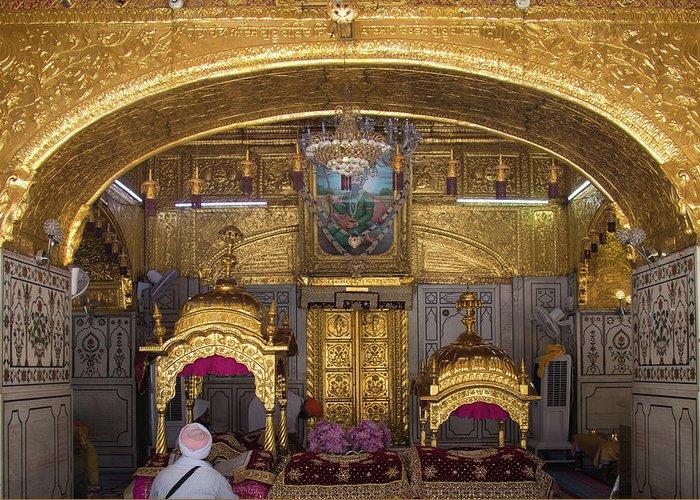
Before the SRM (Sikh Rehat Maryada) was established, many Gurdwaras were run by Mahants. These Mahants were outright corrupt, immoral and staunch Brahmins.
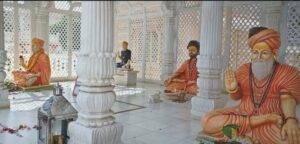
During the times of British rule in Punjab, they were hired by the British to run the Gurdwaras that were left abandoned by Sikhs as Sikhs were still being hunted down and many preferred to continue living in the jungles for fear of their lives.
This also probably explains why during this time, Hindu deity idols were brought in and placed in and around the surroundings (parkarma) of Darbar Sahib, Golden Temple.
After some intense heat from several quarters, in 1906, these statues were removed. Most of the idols were sent to Durgiana Mandir in Amritsar. Some of these idols are still there in the mandir till this date.
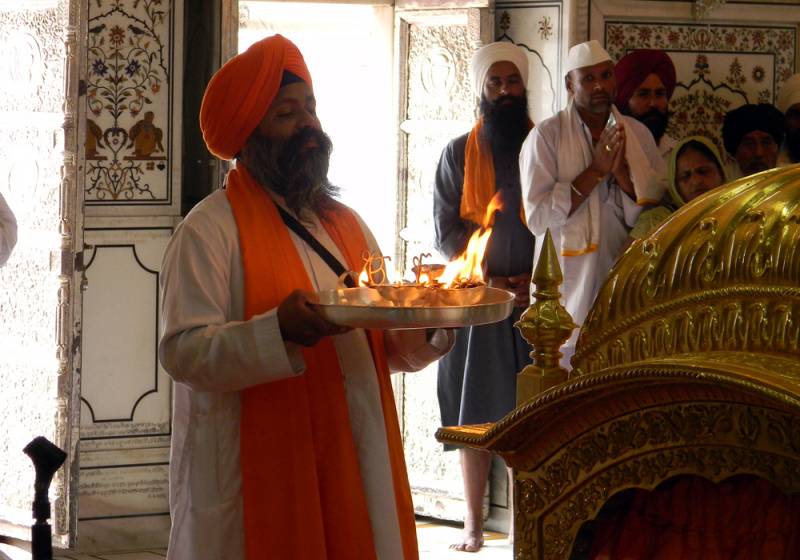
In the case of Takhat Hazoor Sahib and Takhat Patna Sahib, I believe they are still run by the Mahants (perhaps now appearing more Sikh like as they have ditched their orange (Kesari) color clothings, langotis and have adorned the Kurta- Pyjama and the 5 K’s).
FACT: The priests and even head priest of these 2 Takhats still practice various anti- Gurmat Hindu practices till today such as putting the tilak, adorning flowers on photos, doing Aarti with a plate of lamps, slaughtering sheep in the gurdwara compound, putting the blood of the sacrificial animal onto their foreheads and weapons, taking hukamnamas from the Dasam Granth, placing the DG side by side with Guru Granth Sahib and so on.
In Conclusion
Whatever or whomever can write anything they want. Alongside great writings, you will find filth too. It is up to us (as Sikhs of Guru Granth Sahib Ji) to study and understand the messages contained within any writings or compositions.
I know, it’s tough work. Many do not have the time or resources to do an in-depth research. You don’t have to.
We just need to benchmark any writings claiming to be Gurbani against our eternal Guru Dhan Sri Guru Granth Sahib Ji.
The DG has been falsely connected to Guru Gobind Singh. These groups of Udassi, Nirmalas and Mahants have been trying to insert their Hindu Brahmanwaad philosophy, rituals and stories into Sikh literature and scriptures for years – from the time of Guru Arjan Dev Ji.
Guru Arjan NEVER agreed to include any writings or poetry from just about any poet which was in contradiction to Guru Nanak’s AUTHENTIC philosophy. Why would Guru Gobind Singh break this cardinal rule and create another Granth to sit side-by-side with SGGS?
Additional Read: Why was Guru Arjan Dev Ji Martyred? (The Real Reason)
All our Gurus and Bhagats have rejected and redefined the Hindu and Muslim version of religious concepts, God, reincarnation, janam-maran, Chaurasi Lakh Joon, etc. The DG is a twisted book with really twisted characters who want to blemish the good name of Sikhi and our 10th Guru Gobind Singh Ji.
Akaal Takhat and SGPC need to wake up from their slumber!
They need to take responsibility and rectify the DG matter once and for all. Failing to do so may jeopardize the adoption of ‘true Sikhi’ amongst the younger generation. Teenagers today want answers to questions we can’t give or are too shy to talk about.
Let your child read Charitropakhyan or try narrate the meanings of the Hikayats to your child. See if you can.
We need to STOP making excuses and make an extra effort of spending time (daily) reading, understanding, accepting and then applying the teachings of our Gurus and Bhagats (AS CONTAINED WITHIN SGGS). Only then are we going to have a chance to become Sikhs. Real Sikhs. Otherwise, its all a dressing.
We need to be absolutely certain that when Guru Gobind Singh instructed us to bow down in reverence, and when He said “Sabh Sikhan Ko Hukam Hai, Guru Maneo Granth”, He meant to bow down and accept the ONE AND ONLY Sri Guru Granth Sahib Ji and NO other. Period!
If the DG carried Godly wisdom (Tatt Gyan), then why do we feel shy or disgusted after reading it? You won’t feel that way reading the SGGS. Why? Because one is Sacha gyaan (SGGS) and the other is Chutha gyaan (the DG).
If the content of DG has so much of rubbish, how can we allow it to be placed side-by-side with Guru Granth Sahib Ji? How can we be reciting stanzas from the DG (calling them shabads) and doing Kirtan in the Gurdwaras in the presence of Dhan Sri Guru Granth Sahib Ji?
When the Sikh Panth keeps silent to these acts, who is actually destroying the very fabric of Sikhi? We are!
Our silence has given prominence to anti-Sikhs, self-centered scoundrels, thugs and greedy leaders wearing religious garbs and calling themselves Gianis and Parchaaraks (except for a handful few) to carry out their broad day-light robberies.
The general Sikh clergy will not get into a debate or even talk about the DG openly (even though they know the truth) fearing of losing their jobs, rice bowl and wealth pursuing efforts.
These ill-individuals will stoop so low to even allow others to put a blemish on the 10th Guru’s name. Instead of catching them and penalizing them, we are adorning ‘sirapaus’ and garland of flowers around their necks. Why aren’t we doing something to stop this falsehood which has creeped into the Panth?
Whilst we are bowing down in reverence to Guru Granth Sahib, we are INDIRECTLY also showing disrespect by placing a man-made dubious book side by side with SGGS. Where is the common sense in this?
Here is a shabad by Guru Amardas Ji:
ਸਤਿਗੁਰੂ ਬਿਨਾ ਹੋਰ ਕਚੀ ਹੈ ਬਾਣੀ ॥
ਬਾਣੀ ਤ ਕਚੀ ਸਤਿਗੁਰੂ ਬਾਝਹੁ ਹੋਰ ਕਚੀ ਬਾਣੀ ॥
ਕਹਦੇ ਕਚੇ ਸੁਣਦੇ ਕਚੇ ਕਚੀ ਆਖਿ ਵਖਾਣੀ ॥
…
Satgur Bina Hor Kachi Hai Baani ||
Baani Ta Kachi Satguru Bajho Hor Kachi Baani ||
Kehndey Kachey, Sundey Kachey, Kachi Aakh Vekhani || (SGGS 920 – Guru Amar Das)
Meaning,
There is Sachi baani and there is Kachi baani. Gurbani is considered ‘Sachi’ Baani. That Baani which can be in the form of (stanza, composition, poetry, instructions etc,) if it is devoid of Divine knowledge and wisdom (Satguru) then it is considered ‘Kachi’ (half baked; filth; useless; lies). The ones who utter it are useless, the ones who hear such Baani are useless; liars telling lies to others.
Sri Guru Granth Sahib Ji has always retained its sovereignty as the authentic work and compilation of our Sikh Gurus and Bhagats. No questions there. (EXCEPT for Raag Mala, which I believe was added in more recent times within SGGS). – Will probably write on this topic in the coming future.
The entire Guru Granth Sahib, despite it being a collection and compilation of various poets and Gurus, have one common thread – the thought process and messages contained within SGGS are ONE and it teaches us how to become good by discarding the bad. SGGS aligns us humans towards goodness, kindness, uplifting humanity to realize our truest potential as humans by discarding vices and animalistic behavious and adopting Divine virtues. The DG comes NO WHERE NEAR to this goal.
We need to take a stand pyareo! It’s either we accept the DG whole-heartedly or we discard it completely. There is NO such thing as partial acceptance. Remember, the DG is not Gurbani. You do not need to be afraid of it or feel ashamed. Your devotion and love for the Gurus will still remain intact, so long as you adhere to the teachings of our Gurus contained within SGGS.
Last but not least, remember this shabad as well:
ਬਾਣੀ ਗੁਰੂ ਗੁਰੂ ਹੈ ਬਾਣੀ ਵਿਚਿ ਬਾਣੀ ਅੰਮ੍ਰਿਤੁ ਸਾਰੇ ॥
ਗੁਰੁ ਬਾਣੀ ਕਹੈ ਸੇਵਕੁ ਜਨੁ ਮਾਨੈ ਪਰਤਖਿ ਗੁਰੂ ਨਿਸਤਾਰੇ ॥੫॥
Baani Guru, Guru Hai Baani, Which Baani Amrit Sarey ||
Gurbani Kehai, Sewak Jun Maaney, Partakh Guru Nistaarey ||5|| (SGGS page 928)
Meaning,
Baani (shabad, vichaar, divine wisdom, sacha gyaan) is Guru and the Guru is Baani. Within the Guru’s Baani, there are answers to everything (sarey). Whatever Gurbani says (Gurbani Kehai), we (the sewak) MUST accept and adhere to (jun maaney), and only then one is able to be emancipated – while living, here and now, we will experience peace, bliss and real happiness.)
Forgive me with all my heart if this article has offended you in any way. I hope we will muster the strength and see the DG for what it is.
Have a different opinion? Share in the comments section below.
References
- https://www.searchgurbani.com/dasam-granth/
- Dr Rattan Singh (Jegi) – PhD Dasam Granth
- Prof Inder Singh Ghagga – Dasam Granth Di Asliat
- Dasam Granth Questions and Answers booklet
- https://asiasamachar.com/2016/04/22/qa-dr-karminder-singh-dasam-granth-issue/
- https://www.thestar.com/news/insight/2010/04/11/did_guru_gobind_singh_write_the_dasam_granth.html
- https://en.wikipedia.org/wiki/Dasam_Granth
- https://sgpc.net/?page_id=656
- https://en.wikipedia.org/wiki/Bachittar_Natak
- https://en.wikipedia.org/wiki/Markandeya_Purana
- https://en.wikipedia.org/wiki/Mahakala
- Excommunication of Sikh scholars – http://www.sikhsundesh.net/excommunication.htm

